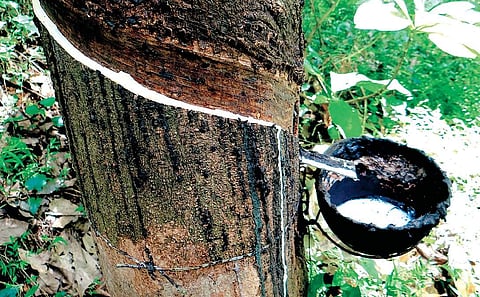

KOTTAYAM: To overcome the damage caused by import of rubber into the domestic market and to increase production, the Rubber Board plans to adopt untapped plantations. Board chairman K N Raghavan has mooted the idea taking into account that a good number of farmers are staying away from tapping owing to the fall in rubber prices and high cost of production.
As per a preliminary study conducted by the Board, around 30 per cent of the total tappable areas are left untapped owing to various reasons and 80 per cent of this untapped area is in Kerala. As per the statistics with the board, rubber production has come down by 1.26 lakh tonnes between 2013-14 and 2018-19, though the tappable area increased by 1.21 lakh hectares. Raghavan said the new plan could be achieved with the help of rubber producers’ societies (RPS) and companies under them.
The board, which observed the limitations of small-scale growers in reducing cost for maintenance, harvesting, processing and marketing of rubber, would undertake the tasks. The companies will appoint tappers for harvesting and the income generated from the sale of rubber will be paid to the growers
after deducting operational costs.
Rubber tappers’ bank to play an optimal role
A tappers’ bank, functioning under RPSs, will be optimally used by assigning them to various plantations to cut down the cost of production. The Board has decided to increase production after the Central Government turned down the demand to restrict the import of rubber, with the divide between demand and supply increasing significantly.
While natural rubber consumption was 12.11 lakh tonnes in 2018-19, actual domestic production was only 6.48 lakh tonnes. Share of imported natural rubber in domestic consumption increased from 37 per cent in 2013-14 to 48 per cent in 2018-19.“We hope a turnaround in the rubber sector within two years and we need to equip ourselves to cash in on the situation. If everything goes as planned, we’ll be able to increase our production within this time,” said Raghavan.
OBJECTIVES
● The objective of the initiative is to promote tapping of rubber trees to ensure that no farm goes untapped
● Adoption of farms will be done through Rubber Producers Societies (RPS) and companies promoted by Rubber Board ● Adoption of farms would involve maintenance of farms, removal of weeds, spraying of pesticides, besides provisions for rain-guarding, tapping of trees and producing sheet rubber from latex
TAPPING STATS
2013-14 2018-19**
Area under natural rubber cultivation (ha) 7,78,400 8,22,000
Area where tapping is possible (ha) 5,18,100 6,40,000
Potential production (tonnes)* 7,77,150 9,60,000
Area where tapping took place (ha) 4,75,200 4,48,000
Actual production (tonnes) 7,74,000 6,48,000
Productivity (kg/ha) 1629 1446
NR consumption (tonnes) 9,81,520 12,11,940
Import (tonnes) 3,60,263 5,82,351
* Assuming cent percent tapping and minimum realisable productivity of 1500 kg per ha.
** Provisional